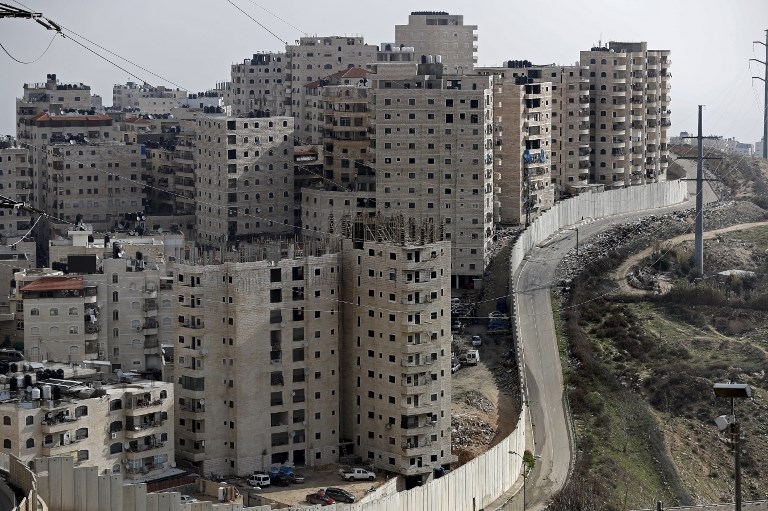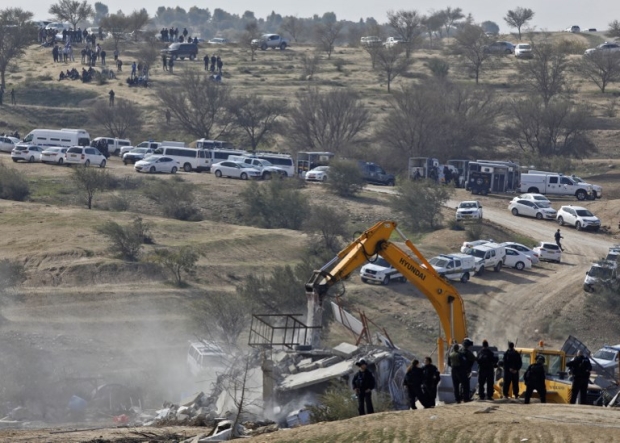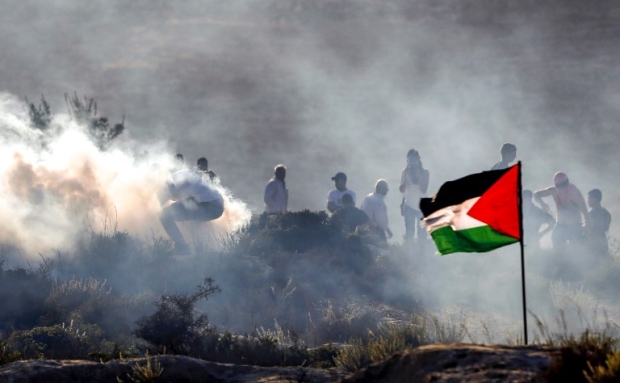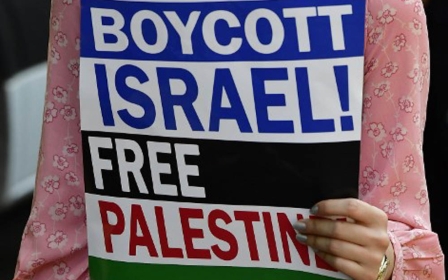The problem with Oslo? It's still alive

An Israeli court has sentenced the Palestinian Bedouin community of Khan al-Ahmar, located east of Jerusalem, to destruction.
Expelled from their homes decades ago during the Nakba - the mass ethnic cleansing on which the state of Israel was built - the Bedouins of Khan al-Ahmar are now being displaced again. This is just one of 20 communities in the area that Israel plans to erase.
This continued ethnic cleansing does not show the failure of the process started with the signing of the Oslo Accords a quarter-century ago, but rather the intended consequences of the agreement itself.
Stratagem of oppression
The Oslo Accords represent a cunning stratagem of oppression, dispossession and fragmentation of our people. After the First Intifada, Israel knew that its crucial tasks were to colonise the land and tighten its control over the occupied people.
As Khan al-Ahmar prepares to face the bulldozers, it is a critical time to revisit these two main modes of domination, hidden behind the historic 1993 handshake on the White House lawn.
The Oslo Agreements were the blueprint for a “Bantustan solution” to the Palestinian issue. Israel saw the agreement's classification of West Bank land into Areas A, B and C as a tool for annexation
In essence, the Oslo Agreements were the blueprint for a “Bantustan solution” to the Palestinian issue. Israel saw the agreement's classification of West Bank land into Areas A, B and C as a tool for gradual annexation. Areas B and C, which comprise the majority of the West Bank, were to be filled with colonies and eventually annexed.
In 1993, fewer than 300,000 Israeli settlers lived in the West Bank (including East Jerusalem), the Gaza Strip and the Golan Heights. Today, more than double that number populate dozens of settlements, and the total continues to rise. Housing units for more than 27,000 settlers were approved in the occupied Palestinian territories in the first six months of 2018.
Since Oslo, Israel has heavily incentivised the construction of settlement infrastructure, including industrial areas, hospitals, universities, agro-businesses and more. The aim is to make the geopolitical map of the West Bank look like all other territory under Israeli control: Israeli industrial and highly developed residential areas surrounded by dispossessed Palestinian communities deprived of basic services.
Policy of expulsion
In 2002, Israel started building its apartheid wall, which surrounds Palestinian cities and villages in the West Bank, isolating them from their land and water reserves and from Jerusalem. Since 1994, Gaza has also been surrounded by a fence, which has as its logical result today’s brutal siege.
The Israeli project of Oslo is completed by a systematic policy of expulsion of Palestinian citizens into restricted residential areas of Israel inside the Green Line and the annexation of the West Bank, starting with the gradual application of Israel’s civil law to settlers, while military rule is restricted to the walled-in ghettos.
The second dimension of the Oslo trap transformed the Palestinian leadership into ghetto administrators. First, the Oslo Accords established the Palestinian Authority (PA), a body meant to oversee the transition towards a Palestinian state, ensuring it would depend in many ways on the occupying forces.
Then, late Palestinian leader Yasser Arafat transferred many powers, such as international relations and oversight for the Palestinian National Fund, the Palestine Liberation Organisation (PLO)’s treasury that finances political parties, to the PA. This made Palestinian political parties and governing institutions captive to the goals of hostile forces.
To make matters worse, a decade ago, the PA ensured that five international structures, including the World Bank and the International Monetary Fund, would control and monitor Palestinian expenses and policies. This effectively ended independent decision-making and imposed neoliberalism as state policy.
Hostage to debt repayment
While the state spends money mainly on security forces, trained by the US and Israel, and phony development projects that create a small but wealthy elite ready to co-exist with the occupation, the large majority of the population is being drowned in growing poverty.
PA support for Palestinian farmers, who are the real protagonists of our resistance and steadfastness, is almost non-existent. Instead, banks are encouraged to give easy loans to people who have lost their livelihoods to the Israeli occupation, making them hostage to debt repayment and less able to confront the occupation.
The ongoing split between Hamas and Fatah is further fragmenting the Palestinian people, changing the question from how to build an effective leadership for liberation to who will administer the Bantustans.
We have reached one of the most critical points in the history of our struggle for justice. Israel’s racist ideology - based on the principle of one ethno-religious group dominating a state built on somebody else’s land and defended by infinite wars and walls - has ardent supporters across the globe, from US President Donald Trump, to Indian Prime Minister Narendra Modi, to the rising right in Europe.
Collective duty
This emboldens Israel and the Trump administration to go beyond Oslo and unilaterally brush off core questions related to the Palestinian struggle. Ignoring international law and consensus, the White House recognised Jerusalem as Israel’s capital, and may arbitrarily reduce the number of Palestinian refugees it recognises by nine-tenths. It has already defunded the UN relief agency for Palestinian refugees (UNRWA).
Our leadership is clearly not in a condition to respond to this offensive, nor to the needs of its people and our struggle. Hence, it is up to all of us to shoulder the collective responsibility of ensuring the survival of the Palestinian people.
We have to bury the nefarious legacies of the Oslo process to make space for new alternatives. We need accountable, democratic leadership, and decision-making structures that can translate our people's readiness for sacrifice and collective action into a common programme and vision - one that rejects “state building” under occupation.
Ours is a liberation struggle. Instead of praising “security cooperation” with the occupying power and haggling over borders, we have to get back to radically challenging the Zionist project of ethnic exclusivity and supremacy. The demands of social justice must take priority on a platform of equality and democracy, away from the disputes and bickering of political parties.
Moving beyond Oslo
We need to continue disentangling our international relations from the Oslo Accords. After 1993, many countries ended their boycott of Israel without first demanding an end to Israeli violations of Palestinian rights. Today, we need to demand that accountability and justice precede engagement.
The global, Palestinian-led boycott, divestment and sanctions (BDS) movement is a step in the right direction. “Constructive engagement” with an apartheid state and those companies and agencies that support it means rewarding them for human rights violations.
We are ready to build on the ruins of yet another destroyed village a new, a post-Oslo generation of struggle that has learned the lessons of the past
While Israel prepares its bulldozers to wreck the lives and homes of the residents of Khan al-Ahmar, we call on our own people and the international community to sanction and boycott Israel and the corporations that provide the bulldozers it uses for our ethnic cleansing.
We are ready to build on the ruins of yet another destroyed village a new, a post-Oslo generation of struggle that has learned the lessons of the past. It will not be easy, but Israel leaves us no other option. Our people have shown that steadfastness - sumud - is born again every day in Palestine.
- Jamal Juma was born in Jerusalem and attended Birzeit University, where he became politically active. Since the First Intifada, he has focused on grassroots activism. Juma has been since 2002 the coordinator of the Palestinian Grassroots Anti-Apartheid Wall Campaign and since 2012 the coordinator of the Land Defence Coalition, a network of Palestinian grassroots movements.
The views expressed in this article belong to the author and do not necessarily reflect the editorial policy of Middle East Eye.
Photo: Buildings in the Palestinian Shuafat refugee camp are surrounded by the Israeli separation wall on 30 January 2018 (AFP)
New MEE newsletter: Jerusalem Dispatch
Sign up to get the latest insights and analysis on Israel-Palestine, alongside Turkey Unpacked and other MEE newsletters
Middle East Eye delivers independent and unrivalled coverage and analysis of the Middle East, North Africa and beyond. To learn more about republishing this content and the associated fees, please fill out this form. More about MEE can be found here.







